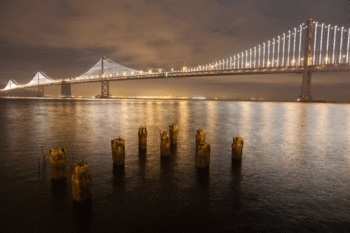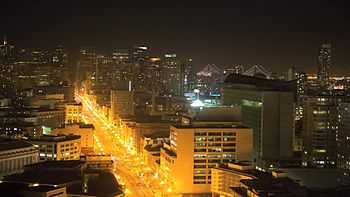The Bay Lights



The Bay Lights is a site-specific monumental light sculpture and art installation on the western span of the San Francisco–Oakland Bay Bridge, designed to commemorate the 75th anniversary of its opening. The installation by light artist Leo Villareal includes 25,000 individual white LEDs along 1.8 miles (2.9 km) of the cables on the north side of the suspension span of the bridge between Yerba Buena Island and San Francisco. The installation is controlled via a computer and displays changing patterns that are not meant to repeat. The opening ceremony was held on March 5, 2013.[1]
Initially intended as a temporary installation to end on March 5, 2015, the project has been confirmed to become a longstanding feature of the Bay Bridge, with a permanent fixture to be installed by early 2016.[2]
Origin of the project
The Bay Lights was conceived by Ben Davis of Words Pictures Ideas, a public relations company that has a contract with the California Department of Transportation (Caltrans) for publicizing the construction of the new span of the Bay Bridge between Yerba Buena Island and Oakland.[3] Davis characterized the Bay Bridge as being overshadowed by the Golden Gate Bridge, which is a popular tourist destination for visitors to San Francisco, and he hoped this art project would give it more recognition.[4]
Construction
The 25,000 white LEDs were attached by construction workers along the vertical steel support cables that connect the deck of the bridge to the suspension cables at the top. Caltrans workers intermittently closed a lane of traffic on the bridge late at night so electricians could install the individual LEDs to the cables.[5][6] The lights are programmed to create a series of abstract patterns that ascend and descend the cables and appear to cross the bridge.[7] Villareal said the patterns will be inspired by weather patterns, tides, and the volume of traffic on the bridge at any given time.[8] The installation will operate from dusk until 2 am daily.[3]
The sculpture is visible from the north side of the bridge and will be most easily seen from the San Francisco waterfront. The lights are positioned to be invisible to bridge motorists, to prevent driver distractions.[9] The lights need 100,000 feet (30,000 m) of special cabling to power the installation, as well as for networking and communications with the control computer. The lights are spaced every 12 inches (30 cm) and are attached to the bridge with 60,000 zip ties.[5] Each LED bulb can be adjusted for 255 different levels of brightness and the entire installation is controlled remotely by a computer program operated by Villareal.[3] The LED lights will complement the permanent string of lights that has been attached to the suspension cables since the 50th anniversary of the bridge in 1986.[3]
A list of credits to those who worked on the Bay Lights project can be found at: http://dev.thebaylights.org/team/
Cost
The project cost $8 million, which was raised through private donations and contributions.[5] Project supporters raised a total of $8.7 million, greatly exceeding the amount needed to complete the project.[6] 50 million people are estimated to see The Bay Lights by 2015,[5] and the project could bring up to $100 million in tourism revenue to the Bay Area.[8] ZERO1, a non-profit dedicated to bringing art and technology together, signed on as the official fiscal sponsor of the project.[10]
The Bay Lights is estimated to use approximately $30 per day in electricity,[11] and have a total operating cost of $11,000, which has been donated by a private solar investment company in the form of solar credits.[12]
In July 2014, Illuminate the Arts announced it was partnering with Tilt.com to sponsor a $1.2 million crowdfunding campaign to keep the Bay Lights lit until 2026.[13]
Inspiration
Both Davis and Villareal suggest The Bay Lights was influenced by their experiences at the annual Burning Man art and music festival in northwestern Nevada. Villareal first attended Burning Man in 1994 and eventually joined the board of directors of the Burning Man organization. His prototype light sculpture was 16 blinking lights in a grid that was meant to be a beacon when returning to his camp at night.[5] From there, Villareal has programmed more complex light matrices and exhibitions, including his largest, "Multiverse," a 41,000 LED installation on permanent display at the National Gallery of Art in Washington, DC.[3]
Reception and supporters
Since its inauguration, The Bay Lights has received widespread public support and positive reaction, as well as political support from state and local politicians, including Governor Jerry Brown, Lieutenant Governor Gavin Newsom, San Francisco Mayor Ed Lee, the San Francisco Board of Supervisors and former San Francisco Mayor Willie Brown.[5][8]
Hemispheres named The Bay Lights the top attraction in its 2013 "Out with the Old, In with the New" Top-25 feature.[14]
On March 8, 2014, the documentary Impossible Light world premiered at the SXSW Film Festival. The film follows the people who wished to produce The Bay Lights as they search for funding and obtain permits. The Austin Chronicle felt that the documentary was a nearly seamless extraction of the evolutionary relationship between art and benefaction.[15] The film will also be screening as part of the 57th San Francisco International Film Festival and the Newport Beach Film Festival in April 2014.[16][17]
Notes
- ↑ "‘The Bay Lights’ Officially Unveiled On Bay Bridge". KPIX-TV. March 6, 2013. Retrieved March 6, 2013.
- ↑ Egelko, Bob (17 December 2014). "Bay Bridge light show will go on". SF Gate. Retrieved 6 February 2015.
- ↑ 3.0 3.1 3.2 3.3 3.4 Whiting, Sam (2012-09-18). "Bay Bridge to beam vivid light sculpture". San Francisco Chronicle. Retrieved 18 January 2013.
- ↑ McMenamin, Dan (2012-09-18). "Art project to illuminate Bay Bridge". Bay City News via San Francisco Examiner. Retrieved 19 January 2013.
- ↑ 5.0 5.1 5.2 5.3 5.4 5.5 Fischer, Adam (2012-11-29). "Bright Idea". The New York Times. Retrieved 18 January 2013.
- ↑ 6.0 6.1 Musiker, Cy (2012-07-12). "Bay Bridge Lightshow on Schedule For March Debut". KQED. Retrieved 19 January 2013.
- ↑ Kuang, Cliff (2011-06-11). "Big-Time Techies Want To Turn SF’s Bay Bridge Into A Glittering Light Show". Fast Company. Retrieved 18 January 2013.
- ↑ 8.0 8.1 8.2 Sharpe, Katherine (2012-05-29). "Everything Will Be Illuminated: Artist to Cover Bay Bridge in Programmable LEDs". Wired. Retrieved 18 January 2013.
- ↑ Cuff, Dennis (2012-12-27). "25,000 lights to turn Bay Bridge span into giant night sculpture". Contra Costa Times. Retrieved 18 January 2013.
- ↑ The Bay Lights Press Facts Sheet. Retrieved June 8, 2013.
- ↑ Hoge, Patrick (2012-09-18). "Huge Bay Bridge light project going ahead". San Francisco Business Times. Retrieved 18 January 2013.
- ↑ Tarantola, Andrew. "Art Backers Want to Light Up The Bay Bridge". Gizmodo. Retrieved 18 January 2013.
- ↑ Kung, Michelle. "Let There Be Light: 40 Days to Save the Bay Lights". Tilt Blog. Retrieved 22 August 2014.
- ↑ "Out With the Old". Hemispheres (United Airlines). 2013-01-01. Retrieved 19 January 2013.
- ↑ Winkler, Jeff (March 12, 2014). "SXSW Film Review: 'Impossible Light' –". Austin Chronicle.
- ↑ http://www.sffs.org/festival-home/attend/film-guide/impossible-light#.UzyRfq1dWjQ
- ↑ http://newportbeach2014.festivalgenius.com/2014/films/impossiblelight_jeremyambers_newportbeach2014
http://dev.thebaylights.org/team/ http://impossiblelightfilm.com/about/credits/ http://www.theatlantic.com/sponsored/cadillac-bay-lights/ http://www.amazon.com/Impossible-Critchett-Northrup-Cipriani-Villareal/dp/B00MH666RQ http://www.wired.com/2013/05/exclusive/ http://www.colorkinetics.com/showcase/installs/San-Francisco-Bay-Bridge/ http://urbanomnibus.net/2012/10/sequence-of-light-a-conversation-with-leo-villareal/ http://www.cnet.com/news/behind-the-scenes-with-the-worlds-largest-led-art-project/ http://www.news.cornell.edu/stories/2012/10/leo-villareals-cosmos-glow-johnson-museum http://www.keithsamsel.com/b00mh666rq_impossible-light.html
External links
- The Bay Lights official website